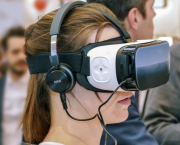
Gamification in Healthcare — Four practical Implementation to be popular by 2023
 8 min
8 min
Gamification in Healthcare — Four practical Implementation to be popular by 2023

Gamification has gotten onto the scene and, mainly because of the quality of its hardware support, its practical implementation - from fintech to healthcare - is evolving.
Gamification is a powerful tool for a multitude of industries and even consumers. As the tech industry is growing, it gives us the promise of brighter days ahead.
This article covers four practical ways gamification will change the healthcare industry for the years to come.
Inside The Gamification World
Gamification is the implementation of elements of game thinking, video games, and game mechanics to facilitate solving everyday real-life issues. In the business and social world, it is used to improve skills, alter behavior and facilitate innovation.
Here’s how Bernadette Keefe puts it: “The goals of gamification in healthcare would be to effect personal and societal behavior change.”
In healthcare, it is still at a baby stage and is generally applied to health and well-being as a motivational and educational asset to teach and have patients to take actions profitable to their health and body. Simply put, the main goal of gamification is to alter patient behavior.
After years of brilliant experiments in other industries, it seems that the health and health insurance industries have finally taken notice and are looking into it. The uncountable numbers of wearables and health and wellness applications with gamification features is clear proof of this.
Today, there are hundreds of applications, and companies working to make gamification possible in the healthcare industry.
Gamification In Healthcare Ages Ago
The first wave of application development with gamification focused on industries such as lifestyle, fitness, and nutrition.
Lifestyle and Fitness
Mobile devices like the Nike+Fuelband, Jawbone UP24 and Fitbit Force enable users to track their progress and health stats and connect with other users to compare data.
Nutrition, Weight Management, and Obesity
With obesity being a major trend, applications such as HealthMonthTM — that help users control their diet and reduce weight — have a tremendous market. These applications are meant to track health indicators and allow challenges and rewards.
Gamification in Healthcare for the Years to Come
The global gamification market size is expected to reach over $34 billion with a Compound Annual Growth Rate of ~31% by 2025. Technologies such as AIoT and likes are projected to change the game pretty faster in industries like healthcare. Moreover, with gamification techniques such as rewards, levels, goals, badges, and others, organizations can reduce their development and learning costs.
In the healthcare world, both physicians and patients have huge expectations from gamification. And the gamification market leaders are working to relate.
In a recent study, Adroit Market Research has made some predictions and here are some-
Physician Training
A study by iHealthBeat reported that physicians who use online video games as their primary learning asset are able to have better results for their patients than their colleagues who use the more traditional techniques of decoding and reading educational materials.
In 2023, physicians will spend less time decoding data collected by sensors and will achieve more with their patients. For instance, they can significantly decrease their patients’ blood pressure levels by making use of gamification materials.
Achieving better results in less time is way more important, as doctors are looking for tools that allow them to spend more time doing what they are paid to do — engage with patients.
To an extent, therapists will become more competitive, as games can inform physicians of the results of their peers so that they could compete with each other — and improve.
Better Surgical Precision
Another use of gamification will be in surgery. Surgeons can play video games to hone their surgery skills. As of now, video games are used for the purpose.
In 2023, Virtual Reality, Augmented Reality, and Artificial Intelligence will make things easier, as surgeons can practice live in a real, yet virtual world in order to perform better during laparoscopic surgery.
It’s true that the vast majority of physicians and surgeons are NOT gamers because of the time constraints, however, playing video games will certainly enable them to get used to handling the movements of their laparoscopic devices and operate with precision.
Patient Adherence to Driving
Gamification is also utilized to impact patient behavior. There are a plethora of games aimed at helping users accomplish self-improvement objectives ranging from general improvement to any other fitness goal.
The games track users’ trends towards formerly identified goals and tell what has got to be done over time to achieve those goals. Although weight loss is the most popular use case, gamification is also popular for leading to success by expanding corporal, mental, emotional and social resilience.
Chronic diseases like diabetes and cancer require constant testing and monitoring, but more and more people spend hard times keeping to schedules. Gamification will make it possible for both physicians and patients to interact, yet not being in the same location.
Gamification will also facilitate prevention as there will be more and more games designed to help people take care of their bodies and change diet according to their virtual nutritious diet data.
Physical Therapy
The last use case will help patients with serious injuries. A healthy mind is important for a healthy body. There will be more and more software that’ll help relieve anxiety through deep breathing exercises or anti-stress music or even a journey to a virtual likable environment. A plethora of 3D and AR apps will be available to help people suffering from depression learn cognitive-behavioral therapy techniques to cope with their depression.
In a study conducted several years ago, a manual wheelchair interface called GameWheels was utilized to convert the wheelchair into a joystick that can be controlled by players with their wheels. Players could then play their favorite racing games, fulfilling high levels of activity that they had never accomplished before.
In the years to come, VR will be used to enhance patients’ experience in physical therapy. Patients can easily challenge themselves and speed up their recovery using gamification materials enabling them to practice and exercise in a real yet virtual world.
The increased effectiveness of physical therapy will inevitably translate into much greater patient satisfaction.
Recap’
According to the US Census Bureau, the millennials of generation Y, in the US, is comprised of 100 million people under age 37 and 53% of them are expected to adopt gamification by the end of 2020. These figures just remind us of the crucial role that gamification will be playing in our daily lives no matter the industry.
In healthcare, gamification will offer a new paradigm to all members of the healthcare community and, with technology growing fast, will contribute to increased knowledge and improved outcomes. Consumer demand is evolving, risks are shifting, and investors are jumping in.
Gamification offers a cheap way to have a positive impact on the continuum of care. Administrators favor technologies that provide a relatively quick return on investment, which gamification technologies have done and will do, again. As a result of these factors, the increased presence of gamification in the healthcare sector will continue to resonate with health care providers, as well as investors.









 English
English
 Français
Français
 Deutsch
Deutsch
 Italiano
Italiano
 Español
Español



 Colaborar
Colaborar












 Puedes apoyar a tus escritores favoritos
Puedes apoyar a tus escritores favoritos





